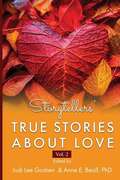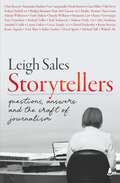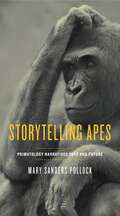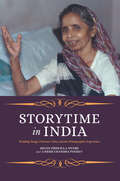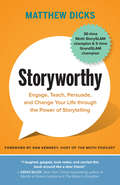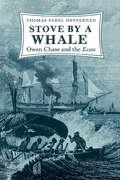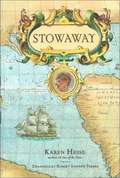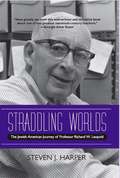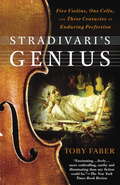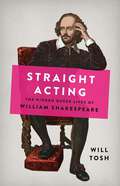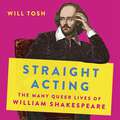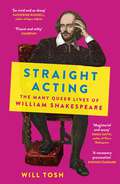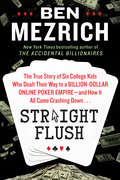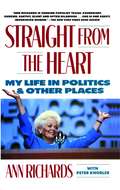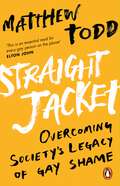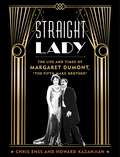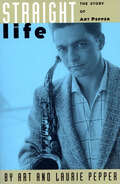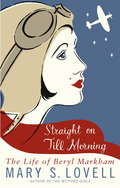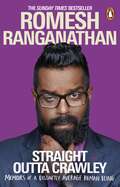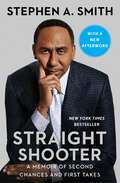- Table View
- List View
Storytellers' True Stories About Love
by Anne E. Beall Judi Lee GoshenIn this second collection, the editors gather thirty more personal stories around the theme of love in all its permutations. in "The Verb to Mother," Mary Dean Cason faces disparagement from a stranger because her child is adopted. In "A Deaf Heart," Dwayne A. Harris learn Sign to support his Deaf brother and his friends. In "That Time We Didn't Die in a Grill Fire," Jaclyn Hamer tells the hilarious story of a near-disaster that helped her family heal after her mother's death. In "Hand, Foot, Hand," Deborah Kent, who is blind, recalls a perilous childhood adventure with her younger brother.
Storytellers: Questions, Answers and the Craft of Journalism
by Leigh SalesHighly respected ABC anchor, bestselling author and hit podcaster Leigh Sales interviews the cream of Australian journalists about their craft – how (and why) they bring us the stories that inform our lives. Leigh Sales is one of Australia&’s most accomplished journalists, having anchored the ABC&’s flagship 7.30 program for twelve years. She has been a foreign correspondent, hosted Lateline and anchored numerous elections for the ABC. In this book, she turns her interviewing skills onto her own profession, those usually asking the questions: the journalists. In ten sections – from News Reporting to Editing, via Investigative, Commentary and of course Interviewing – Sales takes us on a tour of the profession, letting the leaders in their field talk direct to us about how they get their leads, survive in war zones, write a profile, tell a story with pictures, and keep the show on the road. A who&’s-who of Australian journalism – including Lisa Millar, Kate McClymont, Hedley Thomas, Trent Dalton, Benjamin Law, Tracy Grimshaw, Richard Fidler, David Speers, Stan Grant, Niki Savva, Waleed Aly, Annabel Crabb, Karl Stefanovic and Mia Freedman – talk candidly about their greatest lessons and their trade secrets. A fascinating insight into a vital and much-misunderstood profession, Storytellers is a book for anyone who&’s ever wanted to be a journalist, or even just wondered how the news gets made.
Storytelling Apes: Primatology Narratives Past and Future (Animalibus)
by Mary Sanders PollockThe annals of field primatology are filled with stories about charismatic animals native to some of the most challenging and remote areas on earth. There are, for example, the chimpanzees of Tanzania, whose social and family interactions Jane Goodall has studied for decades; the mountain gorillas of the Virungas, chronicled first by George Schaller and then later, more obsessively, by Dian Fossey; various species of monkeys (Indian langurs, Kenyan baboons, and Brazilian spider monkeys) studied by Sarah Hrdy, Shirley Strum, Robert Sapolsky, Barbara Smuts, and Karen Strier; and finally the orangutans of the Bornean woodlands, whom Biruté Galdikas has observed passionately. Humans are, after all, storytelling apes. The narrative urge is encoded in our DNA, along with large brains, nimble fingers, and color vision, traits we share with lemurs, monkeys, and apes. In Storytelling Apes, Mary Sanders Pollock traces the development and evolution of primatology field narratives while reflecting upon the development of the discipline and the changing conditions within natural primate habitat. Like almost every other field primatologist who followed her, Jane Goodall recognized the individuality of her study animals: defying formal scientific protocols, she named her chimpanzee subjects instead of numbering them, thereby establishing a trend. For Goodall, Fossey, Sapolsky, and numerous other scientists whose works are discussed in Storytelling Apes, free-living primates became fully realized characters in romances, tragedies, comedies, and never-ending soap operas. With this work, Pollock shows readers with a humanist perspective that science writing can have remarkable literary value, encourages scientists to share their passions with the general public, and inspires the conservation community.
Storytelling Apes: Primatology Narratives Past and Future (Animalibus: Of Animals and Cultures #5)
by Mary Sanders PollockThe annals of field primatology are filled with stories about charismatic animals native to some of the most challenging and remote areas on earth. There are, for example, the chimpanzees of Tanzania, whose social and family interactions Jane Goodall has studied for decades; the mountain gorillas of the Virungas, chronicled first by George Schaller and then later, more obsessively, by Dian Fossey; various species of monkeys (Indian langurs, Kenyan baboons, and Brazilian spider monkeys) studied by Sarah Hrdy, Shirley Strum, Robert Sapolsky, Barbara Smuts, and Karen Strier; and finally the orangutans of the Bornean woodlands, whom Biruté Galdikas has observed passionately. Humans are, after all, storytelling apes. The narrative urge is encoded in our DNA, along with large brains, nimble fingers, and color vision, traits we share with lemurs, monkeys, and apes. In Storytelling Apes, Mary Sanders Pollock traces the development and evolution of primatology field narratives while reflecting upon the development of the discipline and the changing conditions within natural primate habitat. Like almost every other field primatologist who followed her, Jane Goodall recognized the individuality of her study animals: defying formal scientific protocols, she named her chimpanzee subjects instead of numbering them, thereby establishing a trend. For Goodall, Fossey, Sapolsky, and numerous other scientists whose works are discussed in Storytelling Apes, free-living primates became fully realized characters in romances, tragedies, comedies, and never-ending soap operas. With this work, Pollock shows readers with a humanist perspective that science writing can have remarkable literary value, encourages scientists to share their passions with the general public, and inspires the conservation community.
Storytime
by Jane SullivanWhat was it exactly? Wonder, rapture delight, surprised recognition, laughter – but also darker feelings that made my heart beat fast and my stomach turn over, and sometimes a frantic urge to close the book before whatever it was sucked me in and destroyed me. But always, I read on. In Storytime, author and literary critic Jane Sullivan takes us from Wonderland to Narnia, Moomintroll to Mr Toad and from Winnie the Pooh to the Magic Pudding, to find out why her favourite childhood books were so vitally important, and how they shaped the woman she is today. This intimate, intense and emotional adventure down memory lane is much, much more than nostalgia. It is a surprising and sometimes disturbing voyage of self-discovery. As Jane relives old joys and faces old fears, she discovers that the books were not what she thought they were, and she was not the child she thought she was.
Storytime in India: Wedding Songs, Victorian Tales, and the Ethnographic Experience
by Umesh Chandra Pandey Helen Priscilla MyersAn American ethnomusicologist and her Indian collaborator recount their experiences researching Bhojpuri wedding songs in India.Stories are the backbone of ethnographic research. During fieldwork, subjects describe their lives through stories. Afterward ethnographers come home from their journeys with stories of their own about their experiences in the field.Storytime in India is an exploration of the stories that come out of ethnographic fieldwork. Helen Priscilla Myers and Umesh Chandra Pandey examine the ways in which their research collecting Bhojpuri wedding songs became interwoven with the stories of their lives, their work together, and their shared experience reading The Eustace Diamonds by Anthony Trollope. Moving through these intertwined stories, the reader learns about the complete Bhojpuri wedding tradition through songs sung by Gangajali and access to the original song recordings and their translations. In the interludes, Pandey reads and interprets The Eustace Diamonds, confronting the reader with the ever-present influence of colonialism, both in India and in ethnographic fieldwork. Interwoven throughout are stories of the everyday, highlighting the ups and downs of the ethnographic experience.Storytime in India combines the style of the Victorian novel with the structure of traditional Indian village tales, in which stories are told within stories. This book questions how we can and should present ethnography as well as what we really learn in the field. As Myers and Pandey ultimately conclude, writers of scholarly books are storytellers themselves and scholarly books are a form of art, just like the traditions they study.
Storyworthy: Engage, Teach, Persuade, and Change Your Life through the Power of Storytelling
by Matthew DicksA five-time Moth GrandSLAM winner and bestselling novelist shows how to tell a great story — and why doing so matters. Whether we realize it or not, we are always telling stories. On a first date or job interview, at a sales presentation or therapy appointment, with family or friends, we are constantly narrating events and interpreting emotions and actions. In this compelling book, storyteller extraordinaire Matthew Dicks presents wonderfully straightforward and engaging tips and techniques for constructing, telling, and polishing stories that will hold the attention of your audience (no matter how big or small). He shows that anyone can learn to be an appealing storyteller, that everyone has something &“storyworthy&” to express, and, perhaps most important, that the act of creating and telling a tale is a powerful way of understanding and enhancing your own life.
Stout-Hearted Seven
by Neta Lohnes FrazierRecounts the adventures of the seven Sager children during their journey to Oregon where they were adopted by Marcus and Narcissa Whitman.
Stove by a Whale: Owen Chase and the Essex
by Thomas Farel HeffernanThe &“exciting tale&” of the first documented sinking of a ship by a whale—and the survivor&’s narrative that inspired Moby-Dick (Choice). &“On November 20, 1820, a great whale rammed the Nantucket whaler Essex, two thousand miles west of Ecuador. Owen Chase, her first mate, and twenty-nine other men took to the boats; eight eventually survived. Herman Melville&’s debt to Chase&’s Narrative has been known since Moby-Dick appeared, but little has been known about Chase and the survival of the crew . . .&“Heffernan&’s study belongs on the shelf of every Melville scholar and anyone interested in an exciting tale.&” —Choice&“Moving . . . [Hefferman] has brought together new information about the Essex and her crew, the rescue of her survivors, and subsequent accounts of their ordeal that goes far beyond any single study previously in print.&” —Resources for American Literary Study&“The astonishing list of books, logs, manuscripts, court records, ships&’ registers, and museum records attest to the diligent weeks, months, and even years that have finally resulted in a volume that entrances the reader with yarns of the sea. All the drama is still there, intact.&” —OceanIncludes illustrations.
Stowaway
by Karen HesseIn the summer of 1768, an eleven-year-old butcher's apprentice named Nicholas Young climbed aboard a ship, hid himself from captain and crew, and waited to be carried far away from the life he hated in London. Nick didn't know it, but the ship he chose -- H.M.S. Endeavour -- was bound for an astonishing adventure. Captained by James Cook, Endeavour was on a secret mission to discover an unknown continent at the bottom of the globe. During his three-year voyage, Nick encountered hardship and was awed by new discoveries; he weathered danger and proved himself brave when disaster struck; he earned the respect and trust of the gentlemen on board; he made a friend for life. And he made history. An eleven-year-old boy named Nicholas Young really did stow away on Cook's Endeavour. Based on exhaustive historical research and illustrated with evocative drawings by Robert Andrew Parker, Stowaway is Newbery winner Karen Hesse's extraordinary fictional account of the real Nicholas's journey.
Straddling Worlds: The Jewish-American Journey of Professor Richard W. Leopold
by Steven J. HarperRichard W. Leopold was an historian of American foreign policy and professor at Northwestern University. While his books and articles are still relevant, his greatest legacy was as an influence on three generations of students, some of whom, like George McGovern and Richard Gephart, went on to help form foreign policy. One of those students, attorney Steven Harper, has drawn on Leopold's private papers, published works, interviews of Leopold and his own memories, to produce a loving biography of his former professor. More than a tribute, the book is also the story of the last century in America and the experience of a non-practicing Jew caught between total assimilation and anti-semitism. Annotation ©2008 Book News, Inc., Portland, OR (booknews.com)
Stradivari's Genius
by Toby Faber"'Tis God gives skill, but not without men's hands: He could not make Antonio Stradivari's violins without Antonio."-George EliotAntonio Stradivari (1644--1737) was a perfectionist whose single-minded pursuit of excellence changed the world of music. In the course of his long career in the northern Italian city of Cremona, he created more than a thousand stringed instruments; approximately six hundred survive. In this fascinating book, Toby Faber traces the rich, multilayered stories of six of these peerless instruments-five violins and a cello-and the one towering artist who brought them into being.Blending history, biography, meticulous detective work, and an abiding passion for music, Faber embarks on an absorbing journey as he follows some of the most prized instruments of all time. Mysteries and unanswered questions proliferate from the outset-starting with the enigma of Antonio Stradivari himself. What made this apparently unsophisticated craftsman so special? Why were his techniques not maintained by his successors? How is it that even two and a half centuries after his death, no one has succeeded in matching the purity, depth, and delicacy of a Stradivarius?In Faber's illuminating narrative, each of the six fabled instruments becomes a character in its own right-a living entity cherished by artists, bought and sold by princes and plutocrats, coveted, collected, hidden, lost, copied, and occasionally played by a musician whose skill matches its maker's.Here is the fabulous Viotti, named for the virtuoso who enchanted all Paris in the 1780s, only to fall foul of the French Revolution. Paganini supposedly made a pact with the devil to transform the art of the violin-and by the end of his life he owned eleven Strads. Then there's the Davidov cello, fashioned in 1712 and lovingly handed down through a succession of celebrated artists until, in the 1980s, it passed into the capable hands of Yo-Yo Ma. From the salons of Vienna to the concert halls of New York, from the breakthroughs of Beethoven's last quartets to the first phonographic recordings, Faber unfolds a narrative magnificent in its range and brilliant in its detail. "A great violin is alive," said Yehudi Menuhin of his own Stradivarius. In the pages of this book, Faber invites us to share the life, the passion, the intrigue, and the incomparable beauty of the world's most marvelous stringed instruments.From the Hardcover edition.
Straight Acting: The Hidden Queer Lives of William Shakespeare
by Will ToshA dazzling and "highly readable" (Guardian) portrait of Shakespeare as a young artist, revealing how his rich and complex queer life informed the plays and poems we treasure today &“Was Shakespeare gay?&” For years the question has sent experts and fans into a tailspin of confusion. But as scholar Will Tosh argues, this debate misses the point: sex, intimacy, and identity in Elizabethan England were infinitely more complex—and queer—than we have been taught. In this incisive biography, Tosh reveals William Shakespeare as a queer artist who drew on his society&’s nuanced understanding of gender and sexuality to create some of English literature&’s richest works. During Shakespeare&’s time, same-sex desire was repressed and punished by the Church and state, but it was also articulated and sustained by institutions across England. Moving through the queer spaces of Shakespeare&’s life—his Stratford schoolroom, smoky London taverns and playhouses, the royal court—Tosh shows how strongly Shakespeare&’s early work was influenced by the queer culture of the time, much of it totally integrated into mainstream society. He also uncovers the surprising reason why Shakespeare veered away from his early work&’s gender-bending homoeroticism. Offering a subversive sketch of Elizabethan England, Straight Acting uncovers Shakespeare as one of history&’s great queer artists and completely reshapes the way we understand his life and times.
Straight Acting: The Many Queer Lives of William Shakespeare
by Will Tosh'Engrossing, enlightening and hugely entertaining'SARAH WATERS, author of Fingersmith'Brilliant - so vivid and so sharp, fantastically clever and consistently fascinating'KATHERINE RUNDELL, author of Super-InfiniteWas Shakespeare gay? The answer is both simpler and more complex than you might think . . .Shakespeare's work was profoundly influenced by the queer culture of his time - much of it totally integrated into mainstream society. From a relentless schooling in Latin and Greek homoeroticism, to a less formal education on the streets and in smoky taverns, from the gender-bending of the early comedies to the astonishingly queer literary scene that nurtured Shakespeare's sonnets, this is a story of artistic development and of personal crisis.Straight Acting is a surprising portrait of Shakespeare's queer lives - his own and those in his plays and poems. It is a journey back in time and through Shakespeare's England, revealing a culture that both endorsed and supressed same-sex desire. It is a call to stop making Shakespeare act straight and to recognise how queerness powerfully shaped the life and career of the world's most famous playwright.'Magisterial and saucy . . . This fresh account kickstarts the queer canon of English literature: Shakespeare won't go back in the closet again'EMMA SMITH, author of This Is Shakespeare
Straight Acting: The Many Queer Lives of William Shakespeare
by Will Tosh'Engrossing, enlightening and hugely entertaining'SARAH WATERS, author of Fingersmith'Brilliant - so vivid and so sharp, fantastically clever and consistently fascinating'KATHERINE RUNDELL, author of Super-InfiniteWas Shakespeare gay? The answer is both simpler and more complex than you might think . . .Shakespeare's work was profoundly influenced by the queer culture of his time - much of it totally integrated into mainstream society. From a relentless schooling in Latin and Greek homoeroticism, to a less formal education on the streets and in smoky taverns, from the gender-bending of the early comedies to the astonishingly queer literary scene that nurtured Shakespeare's sonnets, this is a story of artistic development and of personal crisis.Straight Acting is a surprising portrait of Shakespeare's queer lives - his own and those in his plays and poems. It is a journey back in time and through Shakespeare's England, revealing a culture that both endorsed and supressed same-sex desire. It is a call to stop making Shakespeare act straight and to recognise how queerness powerfully shaped the life and career of the world's most famous playwright.'Magisterial and saucy . . . This fresh account kickstarts the queer canon of English literature: Shakespeare won't go back in the closet again'EMMA SMITH, author of This Is Shakespeare
Straight Flush: The True Story of Six College Friends Who Dealt Their Way to a Billion-dollar Online Poker Empire and How It All Came Crashing Down...
by Ben MezrichFrom the New York Times bestselling author of The Accidental Billionaires and Bringing Down the House--the sources for the films The Social Network and 21--comes the larger-than-life true tale of a group of American college buddies who brilliantly built a billion-dollar online poker colossus based out of the hedonistic paradise of Costa Rica. One problem: the U. S. Department of Justice was gunning for them. . . . Based on extensive insider interviews and participation, acclaimed author Ben Mezrichs Straight Flush tells the captivating rags-to-riches tale of a group of University of Montana frat brothers who turned a weekly poker game in the basement of a local dive bar into AbsolutePoker. com, one of the largest online companies in the world, on par with some of the behemoths of the Internet. At its height, Absolute Poker was an online empire earning more than a million dollars a day, following savvy business strategy and even better luck. Its founders set up their operations in the exotic jungle paradise of Costa Rica, embracing an outrageous lifestyle of girls, parties, and money. Meanwhile, the gray area of U. S. and international law in which the company operated was becoming a lot more risky, and soon the U. S. Department of Justice had placed a bulls-eye on Absolute Poker. Should they fold--or double down and ride their hot hand? Impossible to put down, Straight Flush is an exclusive, never-before-seen look behind the headlines of one of the wildest business stories of the past decade.
Straight From the Heart
by Ann RichardsFormer Texas Governor Ann Richards describes her early political career, civil rights activism, and family and personal life. Enjoy the humor and insight displayed in her public appearances.
Straight From the Heart
by Jean ChretienJean Chretien won the hearts of Canadians with his unabashed love of his country, his unwavering commitment to federalism, and his abiding faith in the people. In his remarkable best-selling memoir, Chretien recalls in colourful and fascinating detail his beginnings as a populist lawyer from Shawinigan, his rise as an MP and cabinet minister, and, ultimately, his election as Prime Minister of Canada. <P> Straight from the Heart is an entertaining, insightful first-person account of Chretien`s early days organizing for the Liberals in rural Quebec, how a young French-speaking MP learned the ropes in an English-dominated capital, his pride at becoming Canada?s first French-Canadian Prime Minister of Finance, and the dramatic battles he fought side by side with Pierre Trudeau to win the 1980 Quebec referendum and patriate the Constitution with the Charter of Rights. It includes behind-the-scenes descriptions of his two leadership bids and the election campaign that led to a majority Liberal government in 1993. <P> This classic memoir is essential reading for anyone seeking an understanding of one of the most successful, skillful, and popular political leaders of our times.
Straight Jacket
by Matthew Todd'This is an essential read for every gay person on the planet' - Elton John'A really brilliant and moving read for everybody, especially LGBTQI+ people' - Olly Alexander, star of It's A SinStraight Jacket is a revolutionary clarion call for gay men, the wider LGBT community, their friends and family. Part memoir, part ground-breaking polemic, it looks beneath the shiny facade of contemporary gay culture and asks if gay people are as happy as they could be - and if not, why not? Meticulously researched, courageous and life-affirming, Straight Jacket offers invaluable practical advice on how to overcome a range of difficult issues. It also recognizes that this is a watershed moment, a piercing wake-up-call-to-arms for the gay and wider community to acknowledge the importance of supporting all young people - and helping older people to transform their experience and finally get the lives they really want.WINNER BOYZ BEST LGBT BOOK 2017SHORTLISTED FOR THE POLARI BOOK PRIZE 2017'Insightful, inclusive, clever and engaging' - Jeremy Langmead'Utterly brilliant' - The Guardian
Straight Lady: The Life and Times of Margaret Dumont, "The Fifth Marx Brother"
by Chris Enss Howard KazanjianOn October 20, 1882, future actress Margaret Dumont was born in Brooklyn, New York. A Broadway regular by the 1920s, Dumont found lasting fame once she started appearing with the Marx Brothers. Tall and regal in bearing, her character provided the perfect foil to the wisecracking Groucho Marx in a series of films including A Night at theOpera and Duck Soup. Her character&’s seemingly obliviousness to insult led to the widespread belief, encouraged by Groucho himself, that Dumont was a humorless person who never got the joke. a belief she contradicted in a 1942 interview. &“I&’m not a stooge,&” she said. &“I&’m a straight lady. There&’s an art to playing straight. You must build up your man but never top him and never steal the laughs from him. Straight Lady: The Life and Times of Margaret Dumont, "The Fifth Marx Brother" d focuses on the Dumont and her role in the production of the comedy teams' most successful films. Several books have been written about the Marx Brothers as a comedy family and about their individual lives, but there haven&’t been any books written about Margaret Dumont. This book will appeal to motion picture enthusiasts, Marx Brothers&’ fans, and film historians.
Straight Life: The Story Of Art Pepper
by Art Pepper Laurie PepperArt Pepper (1925-1982) was called the greatest alto saxophonist of the post-Charlie Parker generation. But his autobiography, Straight Life, is much more than a jazz book--it is one of the most explosive, yet one of the most lyrical, of all autobiographies. This edition is updated with an extensive afterword by Laurie Pepper covering Art Pepper's last years, and a complete and up-to-date discography by Todd Selbert.
Straight On Till Morning: The Life Of Beryl Markham
by Mary S. LovellBeryl Markham, like Karen Blixen, could only have come out of Africa. Pioneering aviatrix, flamboyant beauty, brilliant race-horse trainer, unscrupulous seducer - her life story is for every reader who was enthralled by Blixen's exotic world, that of Kenya between the wars. This fully authorised biography, drawn from the author's personal association with Beryl and her family, paints a vivid portrait of a tempestuous and controversial character. It tells of her friendship with Karen Blixen (though she commandeered Blixen's husband Bror and lover Denys Finch Hatton), of her spectacular courage when she became the first person to fly from England to America, and of the mysteries surrounding her highly praised, bestselling book WEST WITH THE NIGHT.
Straight On till Morning: The Biography of Beryl Markham
by Mary S. LovellBeryl Markham, was the first person to fly solo from England to America. The full story of her adventures across three continents are revealed in this biography of a lady whose fame was only exceeded by her beauty and controversial character.
Straight Outta Crawley: Memoirs of a Distinctly Average Human Being
by Romesh RanganathanTHE SUNDAY TIMES BESTSELLERStraight Outta Crawley is the hilarious and irreverent autobiography from comedian Romesh Ranganathan.'Very, very funny. I can't recommend it highly enough.' Jonathan Ross_________________________________At the age of 9, Romesh Ranganathan delivered his first ever stand-up set at a Pontin's holiday camp talent competition, smashing the other competitor, a young girl playing the kazoo.The gig went so well that Romesh retired his comic genius for twenty-two years, hiding behind the guise of a maths teacher, before finally revealing himself again (no, not like that) at the tender age of 31. In 2010, Ranganathan staged his epic comeback gig to an almost silent room, and has since gone on to earn his place as the most in-demand overweight vegan Sri Lankan comedian in Britain.Now, for the first time, he tells the full story of how he got here. From the delights of Sri Lankan hospitality to his struggles as a child, teacher and now parent, to his adolescent flirtation with a rap career and his attempts to make it in comedy, Straight Outta Crawley is Ranganathan's hilarious and irreverent autobiography.Have you read Romesh's latest book? As Good As It Gets: Life Lessons from a Reluctant Adult is Romesh Ranganathan's hilarious and painfully accurate dissection of what it really means to grow up.
Straight Shooter: A Memoir of Second Chances and First Takes
by Stephen A. SmithAN NAACP IMAGE AWARD NOMINEE America&’s most popular sports media figure tells it like it is in this &“raw, deeply authentic, and immensely entertaining&” (Bob Iger, #1 New York Times bestselling author and CEO of The Walt Disney Company) book, not only dishing out his signature, uninhibited opinions but also revealing the challenges he overcame in childhood as well as at ESPN.Stephen A. Smith has never been handed anything, nor was he an overnight success. Growing up poor in Queens, the son of Caribbean immigrants and the youngest of six children, he was a sports-obsessed kid who faced struggles, from undiagnosed dyslexia to getting enough cereal to fill his bowl. As a basketball player at Winston-Salem State University, he got a glimmer of his true calling when he wrote a newspaper column arguing for the retirement of his own Hall of Fame coach, Clarence Gaines. Smith hustled and rose up from a reporter on the high school beat at Daily News (New York) to a general sports columnist at The Philadelphia Inquirer before getting his own show at ESPN in 2005. After he was unceremoniously fired from the network in 2009, he became even more determined to fight for success. He got himself rehired two years later and, with his razor-sharp intelligence and fearless debate style, found the show he was destined to star in: First Take, the network&’s flagship morning program. In Straight Shooter, Smith writes about the greatest highs and deepest lows of his life and career. He gives his thoughts on Skip Bayless, Ray Rice, Colin Kaepernick, the New York Knicks, the Dallas Cowboys, and former President Donald Trump. But he also pulls back the curtain and talks about life beyond the set, sharing authentic stories about his negligent father, his loving mother, being a father himself, his battle with life-threatening COVID-19, and what he really thinks about politics and social issues. He does it all with the same intelligence, humor, and charm that has made him a household name. A provocative and moving &“blueprint of tenacity&” (Fat Joe), this book is the perfect gift for lovers of sports, television, and anyone who likes their stories delivered straight to the heart.
